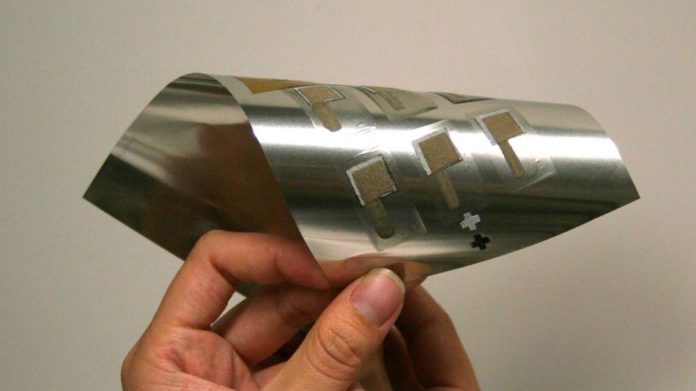Flexible Printed Batteries May Soon Power Wearable Tech

A California startup is developing flexible, rechargeable batteries that can be printed cheaply on commonly used industrial screen printers. Imprint Energy, of Alameda, California, has been testing its ultra-thin zinc-polymer batteries in wrist-worn devices and hopes to sell them to manufacturers of wearable electronics, medical devices, smart labels and environmental sensors.
The company’s approach is meant to make the batteries safe for on-body applications, while their small size and flexibility will allow for product designs that would have been impossible with bulkier lithium-based batteries. Even in small formats, the batteries can deliver enough current for low-power wireless communications sensors, distinguishing them from other types of thin batteries.
The company recently secured $6 million in funding from Phoenix Venture Partners, as well as AME Cloud Ventures, the venture fund of Yahoo cofounder Jerry Yang, to further develop its proprietary chemistry and finance the batteries’ commercial launch. Previous investors have included CIA-backed venture firm In-Q-Tel and Dow Chemical.
The batteries are based on research that company cofounder Christine Ho began as a graduate student at the University of California, Berkeley, where she collaborated with a researcher in Japan to produce microscopic zinc batteries using a 3-D printer.
The batteries that power most laptops and smartphones contain lithium, which is highly reactive and has to be protected in ways that add size and bulk. While zinc is more stable, the water-based electrolytes in conventional zinc batteries cause zinc to form dendrites, branch-like structures that can grow from one electrode to the other, shorting the battery. Ho developed a solid polymer electrolyte that avoids this problem, and also provides greater stability, and greater capacity for recharging.
Brooks Kincaid, the company’s cofounder and president, says the batteries combine the best features of thin-film lithium batteries and printed batteries. Such thin-film batteries tend to be rechargeable, but they contain the reactive element, have limited capacity and are expensive to manufacture. Printed batteries are nonrechargeable, but they are cheap to make, typically use zinc and offer higher capacity.
Working with zinc has afforded the company manufacturing advantages. Because of zinc’s environmental stability, the company did not need the protective equipment required to make oxygen-sensitive lithium batteries.
“When we talk about the things that constrain us in terms of the development of new products, there’s really two that I lose the most sleep over these days. One is batteries and one is displays,” says Steven Holmes, vice president of the New Devices Group and general manager of the Smart Device Innovation team at Intel.
Despite demand for flexible batteries, Ho says no standard has been developed for measuring their flexibility, frustrating customers who want to compare chemistries. So the company built its own test rig and began benchmarking its batteries against commercial batteries that claimed to be flexible. Existing batteries failed catastrophically after fewer than 1,000 bending cycles, she says, while Imprint’s batteries remained stable.
Imprint has also been in talks about the use of its batteries in clothes and “weird parts of your body like your eye,” Ho says. The company also recently began working on a project funded by the U.S. military to make batteries for sensors that would monitor the health status of soldiers. Other potential applications include powering smart labels with sensors for tracking food and packages.
- Recommended from Around the Web (Week Ending July 12, 2014)
- British Government Picks Illumina to Sequence 100,000 Genomes
- How to Build an Evryscope
- Israeli Rocket Defense System Is Failing at Crucial Task, Expert Analysts Say
This article originally published at MIT Technology Review here

